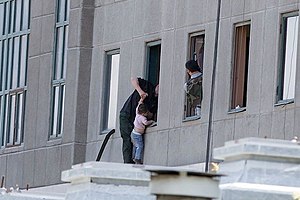| 2017 Tehran attacks | |
|---|---|
| Part of terrorism in Iran, ISIL terrorism, spillover of the Syrian Civil War | |
 | |
 | |
| Location | Islamic Consultative Assembly and Mausoleum of Ruhollah Khomeini, both in Tehran, Iran |
| Date | 7 June 2017 10:50–14:14 IRDT (UTC+04:30) |
Attack type | Suicide bombing, mass shooting, hostage-taking |
| Deaths | 23 (18 victims, 5 attackers) |
| Injured | 52[1] |
| Perpetrators | |
| Assailants | Abu-Jahad, Serias Sadeqi, Ghayom Fatemi, Fereydoun, Ramin Ahmadi[3] |
No. of participants | 5 |
The 2017 Tehran attacks were a series of two simultaneous terrorist attacks that occurred on 7 June 2017 that were carried out by five terrorists belonging to the Islamic State of Iraq and the Levant (ISIL) against the Iranian Parliament building and the Mausoleum of Ruhollah Khomeini, both in Tehran, Iran, leaving 17 civilians dead and 43 wounded.[4][5][6] The shootings were the first terrorist attacks in Tehran in more than a decade,[7] and the first major terror attack in the country since the 2010 Zahedan bombings.[8]
Government officials later stated that they had foiled a third attack that day.[1][7] Iranian security services stated on 8 June that they had identified the five militants responsible for the twin events, disclosing the men's first names, and detailed that they were of Kurdish Iranian background and had returned to Iran in August 2016. The terrorists reportedly served in a clandestine cell linked to Wahhabi-related networks.[9] Some Iranian officials have accused the American, Israeli, and Saudi governments of being behind the attacks.[10][11][12]
On June 13, the Commander of Iran's Islamic Revolutionary Guard Corps (IRGC), Major General Mohammad Ali Jafari, stated that the terrorist attacks were carried out at the demand of Riyadh. "We have precise intelligence showing that unfortunately, Saudi Arabia, in addition to supporting the terrorists, has demanded them to conduct operations in Iran," he said.[13][14]
The formal state funeral took place on 9 June in the context of traditional Friday prayers, and multiple Iranian officials attended such as President Hassan Rouhani, Parliament Speaker Ali Larijani, and Chief Justice Sadeq Larijani. Rouhani's speech stressed national unity, saying that "the nation will undoubtedly emerge victorious".[15][16] On 10 June, security officials stated that they had killed the operational commander and mastermind behind the attacks.[17]
On 18 June 2017, the IRGC launched a series of medium-range precision missiles at an ISIL headquarters in Dayr al-Zawr (Syria) from inside Iran. The retaliatory strikes were, according to an IRGC statement, sending a message to the terrorists and their networks of supporters after the bloodshed in Tehran.
- ^ a b "Iran attacks: 'IS' hits Parliament and Khomeini mausoleum". BBC. 7 June 2017. Retrieved 8 June 2017.
- ^ "Iran attackers fought for Islamic State in Syria, Iraq: ministry". Reuters. Retrieved 8 June 2017.
- ^ "وزارت اطلاعات/هویت عناصر تروریستی حوادث دیروز تهران". vaja.ir. Archived from the original on 20 October 2018. Retrieved 9 June 2017.
- ^ Cite error: The named reference
APwas invoked but never defined (see the help page). - ^ Erdbrink, Thomas (7 June 2017). "Islamic State Claims Deadly Iran Attacks on Parliament and Khomeini Tomb". The New York Times. Retrieved 8 June 2017.
"Iran shootings: Parliament and shrine attacked". BBC. 7 June 2017. - ^ "Shootings reported at Iranian parliament and Khomeini shrine". The Guardian. France-Presse Agence. Retrieved 8 June 2017.
- ^ a b Cumming, Jason; Abdelkader, Rima. "Iran Parliament, Khomeini's Mausoleum Attacked; ISIS Claims Responsibility". Retrieved 8 June 2017.
- ^ Bozorgmehr, Shirzad; Dewan, Angela (7 June 2017). "Iran attacks: Twin assaults on parliament and shrine rock Tehran". CNN. Retrieved 8 June 2017.
- ^ Associated Press (9 June 2017). "Iran attackers 'long affiliated with Wahhabi'". The Standard. Archived from the original on 10 June 2017. Retrieved 11 June 2017.
- ^ Cite error: The named reference
:3was invoked but never defined (see the help page). - ^ Cite error: The named reference
:4was invoked but never defined (see the help page). - ^ Cite error: The named reference
:5was invoked but never defined (see the help page). - ^ "Farsnews". en.farsnews.ir. Retrieved 14 June 2017.
- ^ Entekhab.ir, پایگاه خبری تحلیلی انتخاب |. "فرمانده کل سپاه: اطلاعات دقیق داریم که عربستان عملیات در ایران را از تروریستها مطالبه کردهاست". پایگاه خبری تحلیلی انتخاب | Entekhab.ir (in Persian). Retrieved 14 June 2017.
- ^ "Funeral Procession Held for Iranians Killed in Tehran Terror Attacks (+Photos)". Tasnim News Agency. 9 June 2017.
- ^ "Funeral held for Tehran terror victims". Tehran Times. 9 June 2017.
Rouhani added that it is not the first time the nation witnesses such acts of terror, stressing that "people will find their own path to national goals and unity, and the nation will undoubtedly emerge victorious."
- ^ Cite error: The named reference
Asiawas invoked but never defined (see the help page).